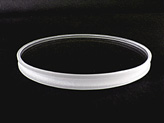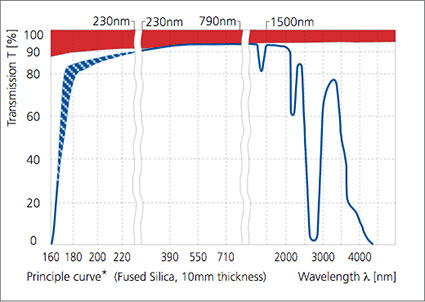Quartz Glass – Synthetic Fused Silica
Special Properties
- Excellent ultraviolet light transmission
- Very high purity
- Outstanding optical performance
- Operating temperature of up to 1000 °C
- Low coefficient of thermal expansion
- Amorphous (non-crystalline) structure
- Crystal-clear appearance
- Very high thermal shock resistance
- Exceptional chemical strength
- High hardness and good scratch resistance
- Good electrical insulation
- Low fluorescence
- Made by a flame hydrolysis process
- Superb mechanical properties
- Machinable by CNC cutting, grinding, and polishing
Typical Applications
- UV and laser optics
- Substrates for mirrors and filter coatings
- Measuring instruments for the UV spectrum
- Wafers for the semiconductor industry
- Photomask blanks
- Microscope slides and cover glasses for medical use
- Optics for high-temperature equipment
- Laboratory test glasses
- Sample-storage solutions
- Space and aviation applications
Related Material Types
- Fused Quartz
(Quartz glass for sight-glass applications) - BOROFLOAT®
(High-temperature borosilicate glass from SCHOTT)
Optical Quartz Glass—Synthetic Fused Silica
Synthetic fused silica is the most commonly used quartz glass type for optics. It is composed of silicon dioxide (SiO₂), produced by flame hydrolysis by melting extremely pure raw materials. This clear, amorphous glass is virtually free of inclusions. It consists exclusively of silicon and oxygen and provides the exceptional clarity and internal quality required for the manufacture of the most demanding optics.
Superb UV transmittance
Because no metals or other contaminants that typically absorb UV light are present in this high-purity material, optical quartz glass offers high transmission at deep ultraviolet wavelengths, which at 185 nm is already greater than 80%. The structure of the pure silicon dioxide in the synthetic glass is extremely homogeneous, which further minimizes absorption and scattering losses in the UV. The optical properties of this material make it ideal for many applications, especially in the ultraviolet spectrum.
Exceptional Thermal Performance
Synthetic quartz glass exhibits outstanding thermal stability, primarily due to its small coefficient of thermal expansion (CTE). It can withstand temperatures up to 1000 °C or higher. Its superb thermal shock resistance allows rapid heating or cooling without cracking, making it particularly valuable for high-temperature applications in the semiconductor industry and aerospace.
High Chemical Strength
Fused silica has remarkable chemical properties. Its strength against acids surpasses that of most other glasses. Only phosphoric acid and hydrofluoric acid are capable of attacking it. In addition, it is resistant to salt solutions, water, and reactive gases. Its stability ensures long-term durability in environments where other glass materials would deteriorate, making it an ideal choice for demanding and corrosive conditions.
Special Electrical Characteristics
Quartz glass is widely recognized for its outstanding insulating resistance. Because mobile ionic impurities are almost absent, it has exceptionally high insulation resistance and is an excellent insulator even under elevated thermal conditions. The material also features a low dielectric constant and maintains stable dielectric properties across a wide spectrum of frequencies, including the gigahertz range. These properties make it a preferred material for high-voltage, high-frequency, and precision electronic applications.
Optics Made of Quartz Glass
 We produce quartz optics for the UV, visible, and infrared spectra, starting with blocks known as boules, which can be selected for minimal inclusions and bubbles. If required by your application, we can achieve refractive index homogeneity as low as ≤ 0.5 ppm. The first step in the fabrication of a quartz optic is cutting the material from the boule. After cutting, the material is shaped and polished to meet specific requirements for flatness and surface quality. This process enables us to manufacture UV-transparent windows, wafers at various thicknesses, slides for microscopy applications, quartz plates, and various other parts daily.
We produce quartz optics for the UV, visible, and infrared spectra, starting with blocks known as boules, which can be selected for minimal inclusions and bubbles. If required by your application, we can achieve refractive index homogeneity as low as ≤ 0.5 ppm. The first step in the fabrication of a quartz optic is cutting the material from the boule. After cutting, the material is shaped and polished to meet specific requirements for flatness and surface quality. This process enables us to manufacture UV-transparent windows, wafers at various thicknesses, slides for microscopy applications, quartz plates, and various other parts daily.
Quartz Glass FAQ
Choosing the right material
Selecting the appropriate quartz glass for a specific application can be challenging due to the variety of grades and their differing properties and costs. Our FAQ page provides guidance to help you select the appropriate material.
To request a quote for optical quartz glass parts with custom dimensions, please select your desired material from the options provided in the table or click the button below.
Specifications
Ultraviolet to infrared transmission
at 160–5000 nm, 10 mm thick
Show full transmission spectrum
Typical transmission
at 185–700 nm, 1 mm thick
Standard Thicknesses
Since fused silica is delivered in unprocessed blocks, there are usually no stock thicknesses. Therefore, a required thickness must typically be specified and manufactured to order. To offer our customers the best possible availability and short delivery times, we continuously grind and polish to some common thicknesses and tolerances, all featuring high-quality optical finishes. These thicknesses can therefore be ordered with individually specified dimensions and short delivery times:
Thickness |
Tolerance |
|
|---|---|---|
| 0.175 | ±0.020 | ✔ |
| 0.30 | ±0.050 | ✔ |
| 0.30 | ±0.025 | ✔ |
| 0.50 | ±0.050 | ✔ |
| 0.50 | ±0.030 | ✔ |
| 0.50 | ±0.025 | ✔ |
| 1.00 | ±0.100 | ✔ |
| 1.00 | ±0.025 | ✔ |
| 1.10 | ±0.100 | ✔ |
| 2.00 | ±0.150 | ✔ |
| 3.00 | ±0.200 | ✔ |
| 3.00 | ±0.025 | ✔ |
| If you require other thicknesses, please send us your inquiry. | ||
TransmissionRefractive index
- T > 80% at 185 nm
Density
- nd = 1.4585
Young's modulus
- 2.20 g/cm3
Homogeneity
- 74 GPa (typical value)
Inclusion classes Glass composition
- Homogeneity classes per specification
- Index homogeneity down to ≤ 0.5 ppm is possible on demand
Operating temperature
- SiO₂
Average coefficient of thermal expansion
- Up to 1000 °C
Viscosity Temperatures
- ≈ 0.57 × 10-6/K
Dielectric constant
- Softening point: ≈ 1585 °C
- Annealing point: ≈ 1042 °C
- Strain point: ≈ 893 °C
- εr: 3.9 (500 MHz)
Fused Silica is not the same as Fused Quartz
In addition to the high-purity grades for optics described on this page, we also offer a less sophisticated type known as natural quartz glass or fused quartz. Although the names are similar, the materials are quite different. Fused quartz contains significantly more impurities than synthetic fused silica because it is made by melting naturally occurring quartz crystals from silica sand. While fused quartz glass also has a similarly clear appearance, it transmits less light in the ultraviolet range but is significantly more economical than fused silica. Even if generally not suitable for demanding applications, fused quartz is an ideal choice for industrial high-temperature sight glasses, lighting equipment, and situations that require good chemical strength, heat resistance, and high transparency. For more details, please refer to our fused quartz data sheet.
Raw materials from all leading manufacturers worldwide
Our company works with non-crystalline quartz glasses from nearly all major suppliers in the industry, including CORNING, Heraeus, Tosoh, SCHOTT, Saint-Gobain Quartz, Shin-Etsu, GE Quartz, and many others. If you are looking for special types or require detailed specs, data sheets, and information about the materials we process, please consider using our request form or emailing us.
Note: Single-crystal or crystalline quartz in general is not in our manufacturing range. We only process amorphous glass materials.
All details and specifications provided are average reference values and are not guaranteed. Please refer to the notes on technical specifications for further information.
© 1994–2025 Präzisions Glas & Optik GmbH
Last update: November 27, 2025




